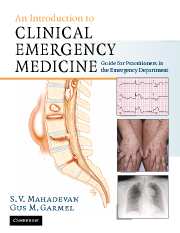Book contents
- Frontmatter
- Contents
- List of contributors
- Foreword
- Acknowledgments
- Dedication
- Section 1 Principles of Emergency Medicine
- Section 2 Primary Complaints
- 9 Abdominal pain
- 10 Abnormal behavior
- 11 Allergic reactions and anaphylactic syndromes
- 12 Altered mental status
- 13 Chest pain
- 14 Constipation
- 15 Crying and irritability
- 16 Diabetes-related emergencies
- 17 Diarrhea
- 18 Dizziness and vertigo
- 19 Ear pain, nosebleed and throat pain (ENT)
- 20 Extremity trauma
- 21 Eye pain, redness and visual loss
- 22 Fever in adults
- 23 Fever in children
- 24 Gastrointestinal bleeding
- 25 Headache
- 26 Hypertensive urgencies and emergencies
- 27 Joint pain
- 28 Low back pain
- 29 Pelvic pain
- 30 Rash
- 31 Scrotal pain
- 32 Seizures
- 33 Shortness of breath in adults
- 34 Shortness of breath in children
- 35 Syncope
- 36 Toxicologic emergencies
- 37 Urinary-related complaints
- 38 Vaginal bleeding
- 39 Vomiting
- 40 Weakness
- Section 3 Unique Issues in Emergency Medicine
- Section 4 Appendices
- Index
32 - Seizures
Published online by Cambridge University Press: 27 October 2009
- Frontmatter
- Contents
- List of contributors
- Foreword
- Acknowledgments
- Dedication
- Section 1 Principles of Emergency Medicine
- Section 2 Primary Complaints
- 9 Abdominal pain
- 10 Abnormal behavior
- 11 Allergic reactions and anaphylactic syndromes
- 12 Altered mental status
- 13 Chest pain
- 14 Constipation
- 15 Crying and irritability
- 16 Diabetes-related emergencies
- 17 Diarrhea
- 18 Dizziness and vertigo
- 19 Ear pain, nosebleed and throat pain (ENT)
- 20 Extremity trauma
- 21 Eye pain, redness and visual loss
- 22 Fever in adults
- 23 Fever in children
- 24 Gastrointestinal bleeding
- 25 Headache
- 26 Hypertensive urgencies and emergencies
- 27 Joint pain
- 28 Low back pain
- 29 Pelvic pain
- 30 Rash
- 31 Scrotal pain
- 32 Seizures
- 33 Shortness of breath in adults
- 34 Shortness of breath in children
- 35 Syncope
- 36 Toxicologic emergencies
- 37 Urinary-related complaints
- 38 Vaginal bleeding
- 39 Vomiting
- 40 Weakness
- Section 3 Unique Issues in Emergency Medicine
- Section 4 Appendices
- Index
Summary
Scope of the problem
Seizures are common presenting complaints to the emergency department (ED). One in twenty of the population will have a seizure during their lifetime. This increases to one in eleven if the patient reaches the age of 80 years. Adults presenting to the ED with a first-time seizure account for nearly 1% of ED visits annually. Seizures have a bimodal distribution, declining in older childhood until age 60, when the incidence increases again. Febrile seizures occur in approximately 3% of children and account for approximately 30% of all childhood seizures. Noncompliance with anticonvulsant medications is the most common cause for seizures in adults less than 60 years of age. The most common cause of seizures in the age group over 60 years is stroke, followed by malignancy. The mortality rate from seizures is reported between 1% and 10%. The highest mortality is with status epilepticus. Seizures can cause permanent neurologic sequelae as well.
Pathophysiology
A seizure occurs when there is excessive, abnormal cortical activity. The clinical manifestations depend on the specific area of the brain cortex involved. A distinction is often made between primary and secondary seizures. Primary seizures are seizures recurring without consistent provocation or cause. Secondary seizures occur as a response to certain toxic, metabolic, or environmental events (Table 32.1). Generalized seizures occur from an electrical event that simultaneously involves both cerebral hemispheres and is accompanied by loss of consciousness. These can be convulsive (grand mal seizures) or nonconvulsive (absence seizures).
- Type
- Chapter
- Information
- An Introduction to Clinical Emergency MedicineGuide for Practitioners in the Emergency Department, pp. 473 - 484Publisher: Cambridge University PressPrint publication year: 2005



